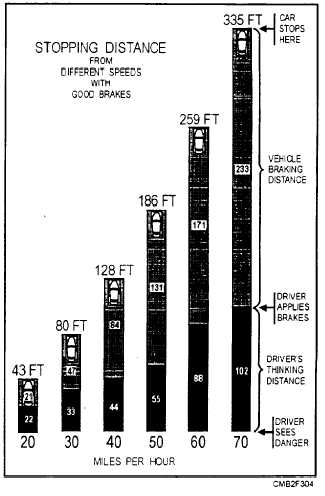by the engine. This is the reason that well-designed, powerful brakes have to be used to control the modern high-speed vehicle.
It is possible to accelerate an average vehicle with an 80 horsepower engine from a standing start to 80 mph in about 36 seconds. By applying the full force of the brakes, such a vehicle can be decelerated from 80 mph to a full stop in about 4.5 seconds. The time required to decelerate to a stop is one eighth of the time required to accelerate from a standing start. Therefore, the brakes harness eight times the power developed by the engine. Thus about 640 (8 x 80) horsepower has to be spent by the friction surfaces of the brakes of an average vehicle to bring it to a stop from 80 mph in 4.5 seconds.
Vehicle Stopping Distance
Operator reaction time is the time frame between the instant the operator decides that the brakes should be applied and the moment the brake system is activated. During the time that the operator is thinking about applying the brakes and moving his or her foot to do so, the vehicle will travel a certain distance depending on the speed of the vehicle. After the brakes are applied, the vehicle will travel an additional distance before it is brought to a stop.
Total stopping distance of a vehicle is the total of the distance covered during the operator's reaction time and the distance during which the brakes are applied before the vehicle stops. Figure 7-3 shows the total stopping distance required at various vehicle speeds, assuming the average reaction time of 3/4 second and that good brakes are applied under most favorable road conditions.
Braking Temperature
Brakes are devices that convert the energy of a moving vehicle into heat whenever the brakes are applied. This heat must be absorbed and dissipated by the brake parts. Unless the heat is carried away as fast as it is produced, brake part temperatures will rise.
Since the heat generated by brake applications usually is greater that the rate of heat dissipation, high brake temperatures result. Ordinarily, the time interval between brake applications avoids a heat buildup. If, however, repeated panic stops are made, temperatures become high enough to damage the brake linings, brake drums. brake fluid, and, in some extreme cases, even tires have been set on fire.

Figure 7-3. - Total vehicle stopping distance of an average vehicle.
Factors that tend to increase brake temperatures include the following:
Load on the vehicle
Operator abuse
Speed of the vehicle
Maladjustment of brakes
Incorrect installation of brake parts
Unbalanced braking
If road speeds are increased and/or more weight is placed in the vehicle, brake temperatures increase. In fact, under extreme conditions of unbalanced brakes on a heavy truck making an emergency stop from high speed, enough heat is generated to melt a cube of iron weighing 11.2 pounds.
Continue Reading